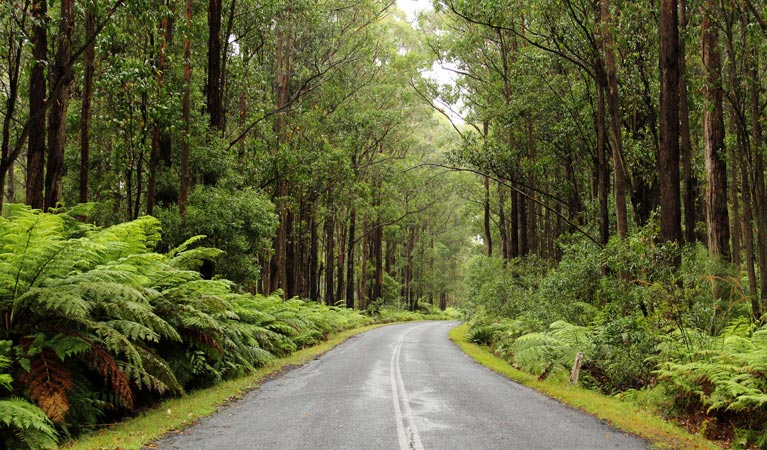South East Forest National Park
Overview
Fancy a spot of birdwatching, horseriding, camping or bushwalking? At South East Forest National Park, near Bega on NSW’s far south coast, you can do all this and more.
Read more about South East Forest National Park
South East Forest National Park is a place that protects soaring old-growth forests, rugged granite formations and picturesque valleys and gorges.
There are more than 100km of spectacular coastal escarpment, tableland edge and hinterland country for you to explore. This beautiful, untamed park is also home to several threatened and endangered species.
See historic sites, hike to lofty peaks, peer from lookouts, and roam through wet fern forest. There are also plenty of opportunities for horse riding and cycling along park trails and picnicking at one of many scenic spots.
The park isn’t far from Bega, Merimbula or Bombala so it makes a great daytrip on the weekend, and if you’re travelling from further afield or feel like a night in the bush, there are a number of quiet campgrounds to choose from and they’re all free. Enjoy the blissful evening of solitude before getting up to explore more of this special place.
Local alerts
For the latest updates on fires, closures and other alerts in this area, see https://www.nationalparks.nsw.gov.au/visit-a-park/parks/south-east-forest-national-park/local-alerts
Map
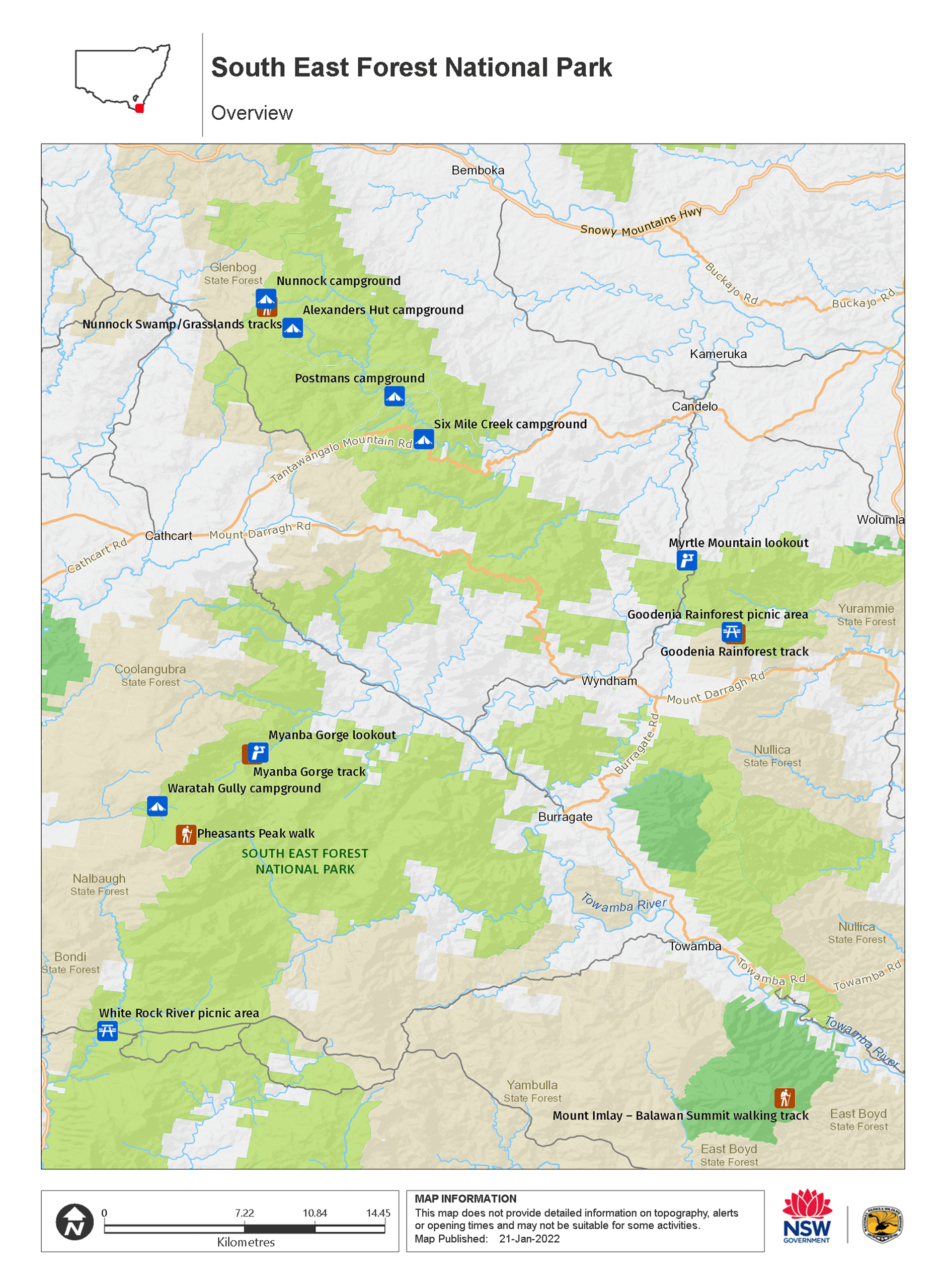
Map legend

Contact
- in the South Coast and Snowy Mountains regions
South East Forest National Park is always open but may have to close at times due to poor weather or fire danger.
-
-
Bombala office
02 6458 5900
Contact hours: Monday to Friday, 8.30am to 4pm. - 153 Maybe Street, Bombala NSW 2632
-
Email: npws.sapphirecoast@environment.nsw.gov.au
-
Bombala office
-
-
Merimbula office
02 6495 5000
Contact hours: Monday to Friday and some weekends during peak holiday periods, 10am to 3pm. - 47 Merimbula Drive, cnr Sapphire Coast Drive, Merimbula NSW 2548
-
Email: npws.sapphirecoast@environment.nsw.gov.au
-
Merimbula office
Visitor info
All the practical information you need to know about South East Forest National Park.
Getting there and parking
Get driving directions
There are many access points for South East Forest National Park and directions will vary depending on which part of the park you would like to visit. General directions are below.
From Merimbula or Pambula, travel south along the Princes Highway. Turn right at Mount Darragh Road for access to Goodenia Rainforest and Wolumla Peak or continue further west towards Bombala.
From Bombala, travel east along Mount Darragh Road and look for signposts to visitor areas within the park.
From Bega, take the Princes Highway south before turning onto Candelo Bega Road, then take Myrtle Mountain Road from Candelo.
Parking
- Myanba Gorge lookout See on map
- Nunnock campground See on map
- Waalimma picnic area See on map
- Waratah Gully campground See on map
By bike
Check out the Bicycle information for NSW website for more information.
Best times to visit
There are lots of great things waiting for you in South East Forest National Park. Here are some of the highlights.
Autumn
Head to the Bombala River in the early morning or late afternoon to see platypuses - look for circular ripple patterns in the water.
Spring
See Nunnocks Swamp and grasslands in its spring bloom glory.
Summer
A great time for a walk in the park – try the easy Goodenia Rainforest walk through a lush gully of ferns covered by a dense canopy of tall lilly pilly trees.
Winter
After a day exploring, get cosy in front of an open fire at historic Alexanders Hut, Nunnocks Swap.
Facilities
Amenities
Toilets Show more
- Alexanders Hut campground
- Goodenia Rainforest picnic area
- Myrtle Mountain lookout
- Nunnock campground
- Pipers lookout
- Postmans campground
- Six Mile Creek campground
- Waalimma picnic area
- Waratah Gully campground
- White Rock River picnic area
Picnic tables Show more
- Alexanders Hut campground
- Goodenia Rainforest picnic area
- Myanba Gorge lookout
- Myrtle Mountain lookout
- Nunnock campground
- Pipers lookout
- Postmans campground
- Six Mile Creek campground
- Waalimma picnic area
- White Rock River picnic area
Barbecue facilities Show more
Maps and downloads
Prohibited
Pets
Pets and domestic animals (other than certified assistance animals) are not permitted. Find out which regional parks allow dog walking and see the pets in parks policy for more information.
Smoking
NSW national parks are no smoking areas.
Nearby towns
Bombala (36 km)
Bombala is a pretty southern Monaro district town on the shores of the Bombala River. It features rolling pastures and dense native forests.
Merimbula (54 km)
The main coastal towns of the Sapphire Coast include Bermagui, Tathra, Merimbula and Eden. This stunning coastline has sparkling beaches and bays, lakes and national parks, all accessible via excellent walking tracks and coastal drives. You'll find beaches just perfect for surfing, swimming and walks.
Eden (75 km)
Eden is a historic whaling town, ideal for a whale-watch tour. It's built around a promontory that juts into Twofold Bay.
Learn more
South East Forest National Park is a special place. Here are just some of the reasons why:
Wildlife haven
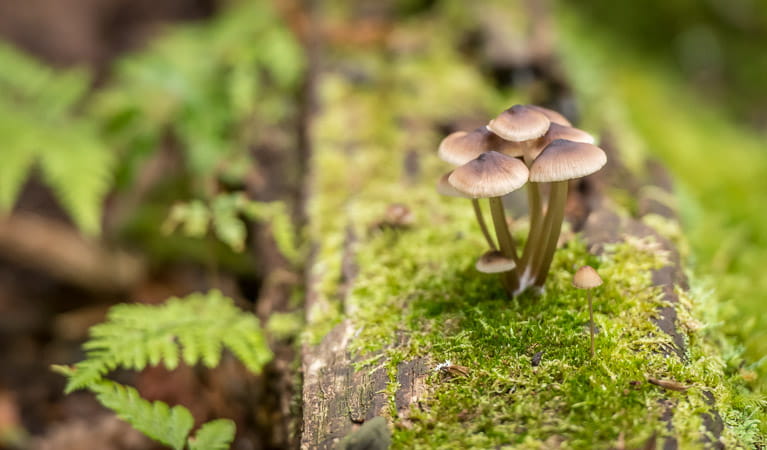
Koalas, powerful owls and giant burrowing frogs are among the threatened species protected within South East Forest National Park. The park also shelters the state's only known populations of endangered long-footed potoroos. Head to White Rock picnic area and look for small conical pits in the ground - evidence of a potoroo's night-time search for fungus. If you're camping overnight at Six Mile Creek or Nunnock campgrounds, listen and watch for nocturnal creatures like gliders and possums.
- Goodenia Rainforest picnic area Combine a barbecue with birdwatching at Goodenia Rainforest picnic area, near Merimbula. The easy Goodenia Rainforest walk starts from this scenic picnic area.
- Waalimma picnic area Located near both Bega and Bombala on the NSW south coast, Waalimma picnic area in South East Forest National Park is great for birdwatching, bushwalking and camping.
Rock on
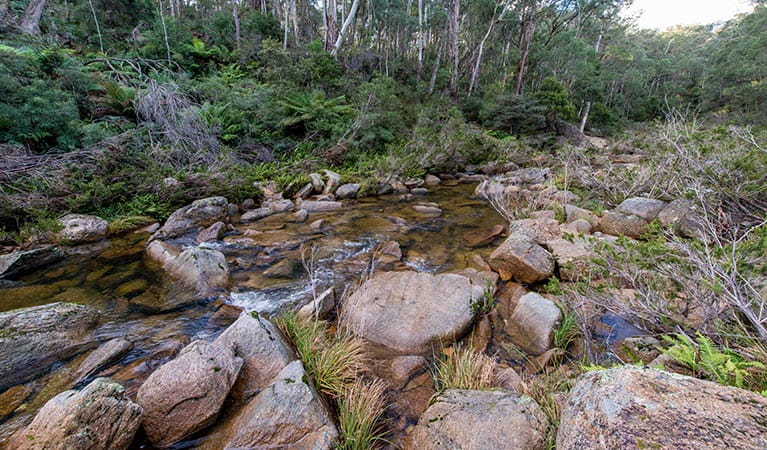
South East Forest National Park protects unique physical features that are sure to appeal to budding geologists, keen photographers and nature-lovers alike. The huge granite tors at Pheasants Peak are the result of volcanic activity and millions of years of weathering and erosion. For a close up view, take the challenging Pheasants Peak walk, you'll also be rewarded with stunning views towards the Snowy Mountains and down the south coast escarpment. Don't miss the elliptically shaped Jingera complex at Jingera Rock near the town of Wyndham; a sheer syenite rockface that is the first reported complex of its type in Australia.
- Goodenia Rainforest picnic area Combine a barbecue with birdwatching at Goodenia Rainforest picnic area, near Merimbula. The easy Goodenia Rainforest walk starts from this scenic picnic area.
- Myanba Gorge walking track Myanba Gorge walking track is a short walk near Bombala with wheelchair-friendly access to the first lookout. It’s great spot for birdwatching and an idyllic place for a picnic.
- Nunnock Swamp and Grasslands walking tracks Go to South East Forest National Park near both Nimmitabel and Bombala for a day walk through the Far South Coast hinterland. Go birdwatching or camping at Alexanders Hut.
- Pipers lookout A good place to stop for a picnic, but Pipers lookout in South East Forest National Park also features stunning views – take the easy boardwalk to see for yourself.
Old-growth
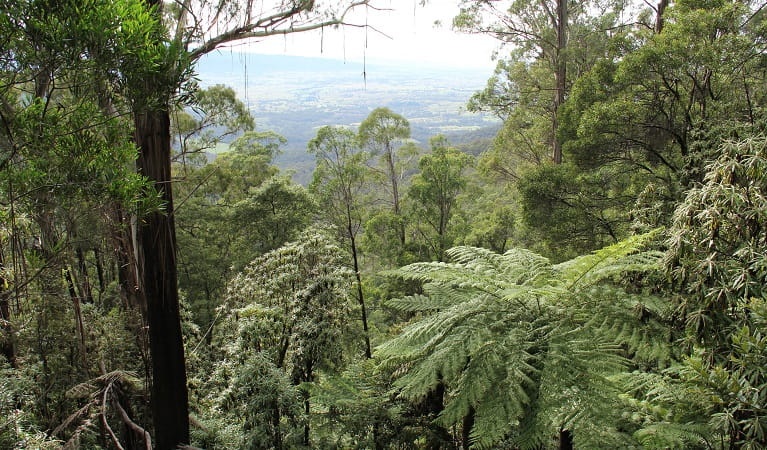
In the early 19th century, explorers, miners, squatters and timber getters led the way into the area that is now South East Forest National Park. The forests within the park were utilised as resources for many years up until the 1980's when their transition to national park commenced. The old-growth forest contains eucalypt trees in their final cycle of growth; trees that provide many different types of nest or home sites for wildlife. Some animals, like large forest owls and glider possums depend on these forests for hollows that develop over long periods of time. Pipers lookout in the northern part of the park is a good place to see old growth forests. Take the short loop walk to see magnificent views of Bemboka and the Bega Valley below, and walk through towering old growth forest.
Ancient connections
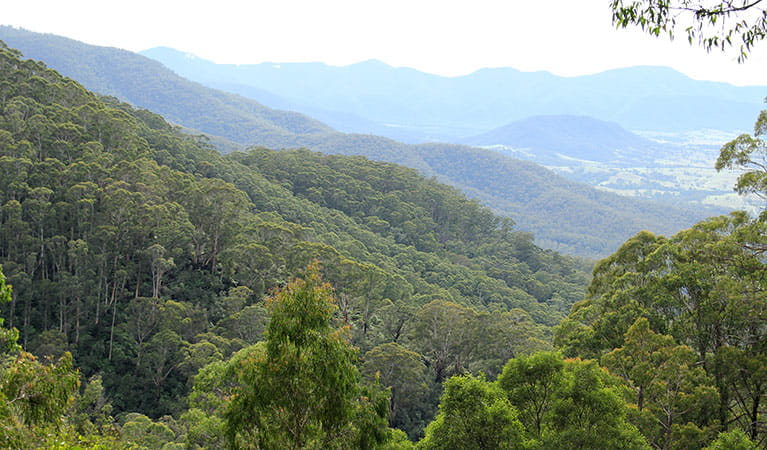
South East Forest National Park is part of the traditional country of the Yuin People, who had a diverse economy and cultural links with neighbouring Aboriginal clans and tribes. South East Forest National Park and the surrounding area provided a diverse food source of animals and fish, a rich resource for weapon and tool construction, as well as a source of medicines and transport. The park protects a number of Aboriginal sites and remains an important landscape for Aboriginal people today.
Plants and animals protected in this park
Animals
-
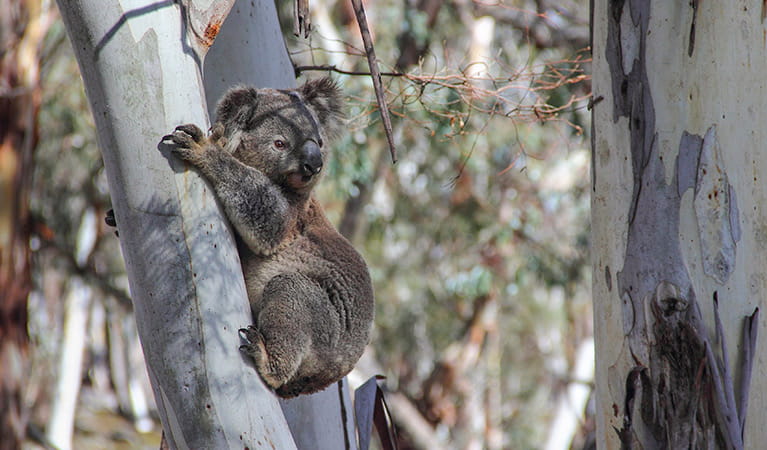
Koala (Phascolarctos cinereus)
One of the most renowned Australian animals, the tree-dwelling marsupial koala can be found in gum tree forests and woodlands across eastern NSW, Victoria and Queensland, as well as in isolated regions in South Australia. With a vice-like grip, this perhaps most iconic but endangered Australian animal lives in tall eucalypts within a home range of several hectares.
-

Swamp wallaby (Wallabia bicolor)
The swamp wallaby, also known as the black wallaby or black pademelon, lives in the dense understorey of rainforests, woodlands and dry sclerophyll forest along eastern Australia. This unique Australian macropod has a dark black-grey coat with a distinctive light-coloured cheek stripe.
-
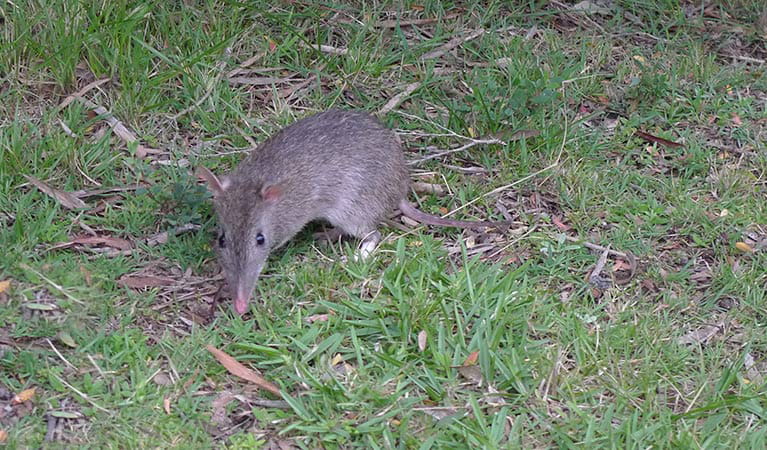
Long-nosed bandicoot (Perameles nasuta)
A nocturnal marsupial and one of the smaller Australian native animals, the long-nosed bandicoot is found across eastern Australia. Populations in the Sydney region have dwindled since European settlement, leaving only endangered colonies in inner western Sydney and at North Head, near Manly. The long-nosed bandicoot has grey-brown fur and a pointed snout which it uses to forage for worms and insects.
-
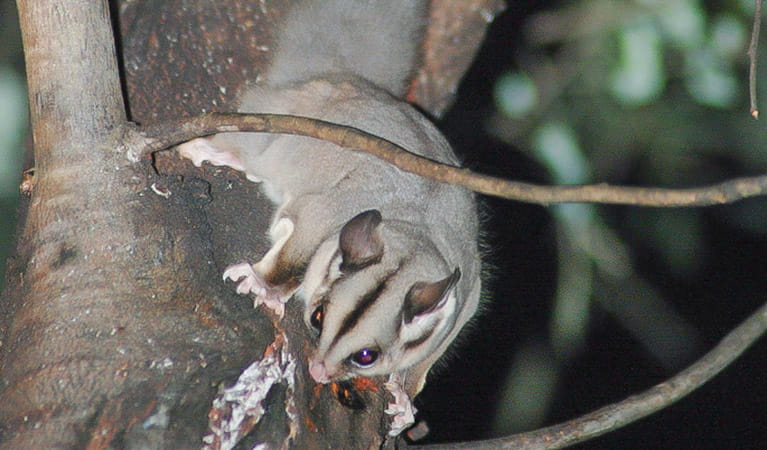
Sugar glider (Petaurus breviceps)
The sugar glider is a tree-dwelling Australian native marsupial, found in tall eucalypt forests and woodlands along eastern NSW. The nocturnal sugar glider feeds on insects and birds, and satisfies its sweet tooth with nectar and pollens.
-

Southern boobook (Ninox novaeseelandiae)
The southern boobook, also known as the mopoke, is the smallest and most common native owl in Australia. With a musical 'boo-book' call that echoes through forests and woodlands, the southern boobook is a great one to look out for while bird watching.
Environments in this park
Education resources (1)
What we're doing
South East Forest National Park has management strategies in place to protect and conserve the values of this park. Visit the OEH website for detailed park and fire management documents. Here is just some of the work we’re doing to conserve these values:
Understanding landscapes and geology
South East Forest National Park ensures its natural landscape is impeccably maintained. NPWS collaborates with other agencies to ensure the aquatic, landscape, geological and topographic values of the park are protected and preserved. All park maintenance and development is carried out with conservation in mind, and efforts to limit the impact of human activity on the land are ongoing.
Preserving biodiversity
NPWS aims to protect the biodiversity of all parks, and South East Forest National Park is no exception. Recovery and pest management programs are in effect to protect the park's native plants and animals. Weed control takes place in this park, along with ongoing research and monitoring activities.
Managing weeds, pest animals and other threats
Pests and weeds have a significant impact to the ecosystems within South East Forest National Park. NPWS carries out risk assessments for new and emerging weeds as well as fox and wild dog control to protect biodiversity in this park.
Developing visitor facilities and experiences
NPWS wants its visitors to have the best possible experience in South East Forest National Park, and works to ensure they are safe and well informed at all times. Displaying current, easily understandable directional and interpretive signage is a continuing priority. Maintenance programs are ongoing in this park, and visitors are kept up to date with any facilities changes or closures.
Conserving our Aboriginal culture
Aboriginal culture is of great value to NPWS, and Aboriginal sites in South East Forest National Park are regularly reviewed and conserved. NPWS works closely with local Aboriginal communities with the goal of maximising their involvement in the park’s ongoing management. Surveying and cultural and conservation programs operate in this park, and Aboriginal cultural values are incorporated into management decisions wherever possible.
Managing fire
NSW is one of the most bushfire prone areas in the world as a result of our climate, weather systems, vegetation and the rugged terrain. NPWS is committed to maintaining natural and cultural heritage values and minimising the likelihood and impact of bushfires via a strategic program of fire research, fire planning, hazard reduction, highly trained rapid response firefighting crews and community alerts.

